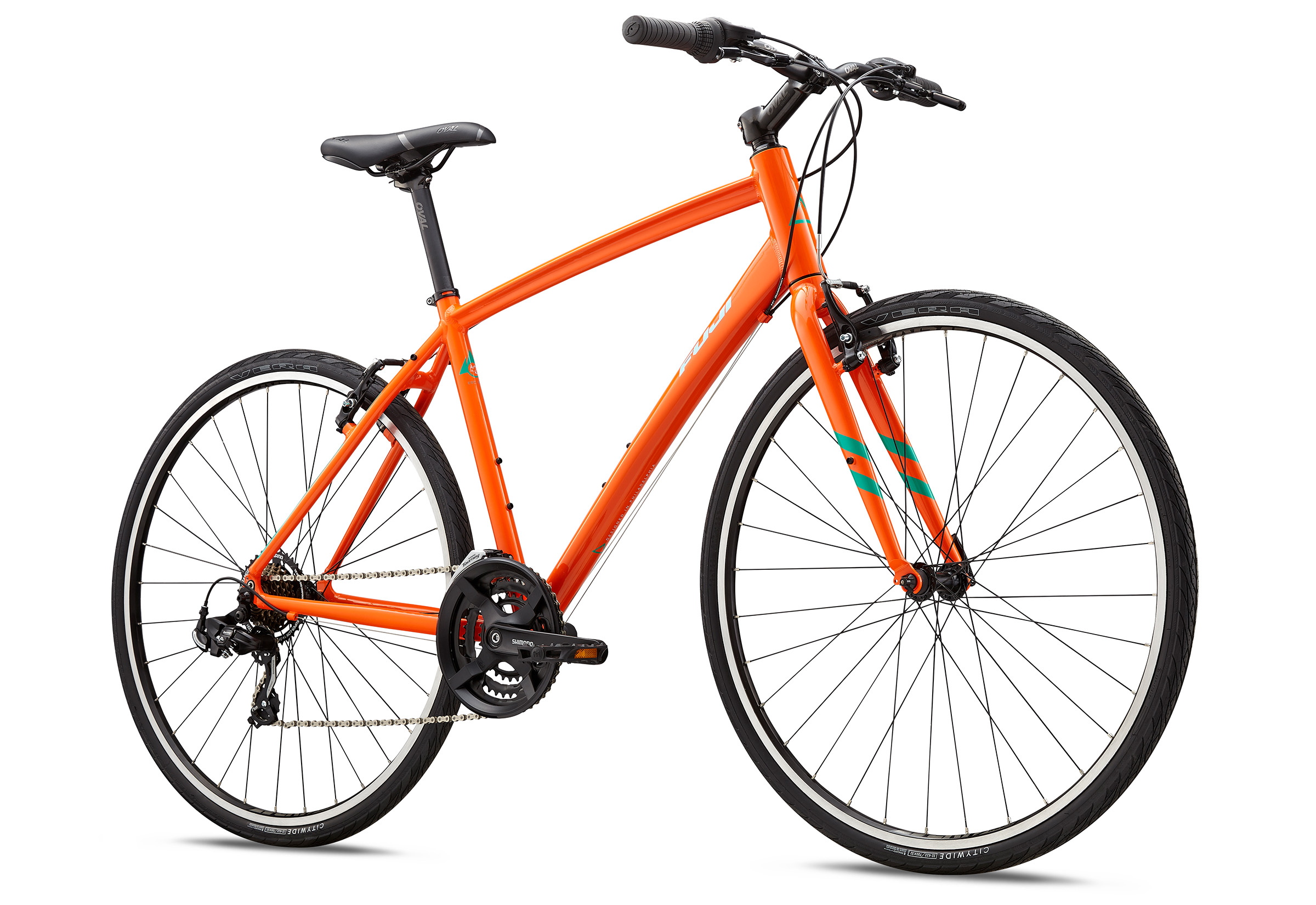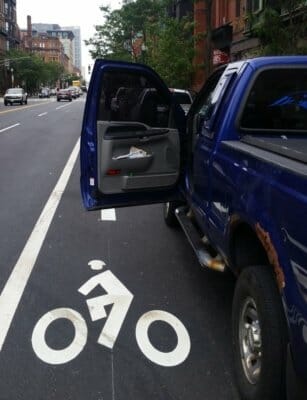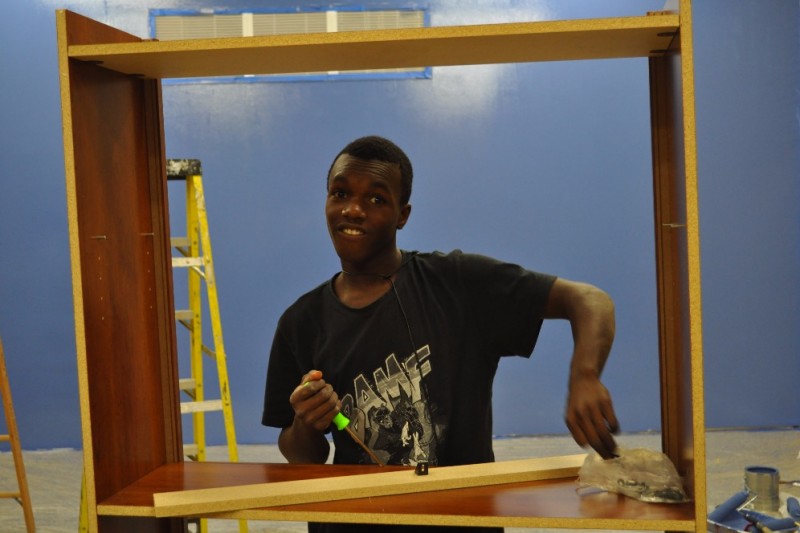
I. The Artful Advocates and the Fair City
Once upon a time in the land of the Massachusett, the streets of the Fair City of Cambridge were dominated by great and fast vehicles. However the older, smaller, and quieter Bicycles could still be found. While many users of the two-wheeled vehicles would travel hither and yon easily, others were afraid of the Foul Beasts that dominated the roads of the land. Truly, most people did not think too much about how they traveled.
The Cycling Cassandras traveled safely by bicycle by following the Eight Safety Commandments:
- Thou shalt not ride on the sidewalk.
- Thou shalt not ride opposite the flow of traffic.
- Thou shalt not ride within reach of the door of a parked car.
- Thou shalt not overtake on the right of a car that could turn right, and especially not a truck or bus.
- Thou shalt not move across the road before checking behind to see that it is safe.
- Thou shalt obey the right of way rules.
- Thou shalt make a turn from the correct place on the road.
- Thou shalt use lights after dark.
A new group arose upon the land. The Artful Advocates looked upon the Foul Beasts and said: Behold, they are many and we are few! They are powerful and we are meek! We need our place on the road! The People will not ride because they are fearful. They will not stop driving their Foul Beasts unless there is a special, safe place for them.
The Fair City said: We hear your cry, Artful Advocates! We will bring you the Line. We will use the Line to divide the road, with one part for the Foul Beasts and another for the Two Wheel People. And lo, it was done: the city added Lines on almost every Street. And the Fair City said: We will also bring you the Symbol that will tell you where you belong. The Line and the Symbol will make you safe.
The Artful Advocates cried out in joy. But the Cycling Cassandras were not happy. They said: You have created bike lanes where riders can be hit by the opening door of a car and where they are told to stay to the right of right-turning cars. Worse, said the Cycling Cassandras, if we follow the Commandments and ignore the Lane and the Symbol, we will incur the Wrath of the Foul Beasts, who have been advised by your bike lanes that Bicycles must stay in their own lanes. You have tried to appease the Daemon Fear, and in so doing you have aroused the Daemon Hatred. For these are the same Creature: the two-headed Daemon Fear-Hatred.
The Artful Advocates said: Stop complaining, Cassandras! Before the Two Wheeled People had Nothing, and now, thanks to the Fair City, they have Something, and Something is better than Nothing! Besides, what is the alternative?
The Cycling Cassandras replied: We are very glad you asked! We would love to have smooth streets without bumps, holes, or other hazards! Those detectors that make the lights turn? It would be so awesome if they did that for bicyclists too! Traffic calming, lower speed limits, and traffic enforcement focused on improving safety and equally applied to all users! Most of all, we should make sure that everyone knows that bicyclists have equal rights to use as much of the road as necessary! And we would like our Commonwealth to mete out harsh and cruel punishment to drivers of Foul Beasts who threaten and assault bicyclists; specifically, the loss of the privilege of driving for one year!
The Fair City said: Bicycles and Cars, Same Roads, Same Rules. But in time the City forgot.
Time passed and the number of Two Wheel People increased as a new generation came upon the land, and saw that bicycling was cool and fun. It might also have helped that the price of gasoline increased from two dollars per gallon in the year 1998 to almost five dollars (in current dollars) in the years 2008, 2011, and 2012.
Yet the Artful Advocates were not content. They knew that the area next to the parked cars and the area in intersections and driveways was the Danger Zone. The Fair City said: We will bring forth the Color to mark the Danger! With the Line, the Symbol, and the Color, you truly will be safe! And it was done.
The Artful Advocates were still not content. Bicyclists were more numerous in the Distant Lands. They began to realize that bicycling between Moving Cars and Parked Cars was Stressful. They said to the City: You have brought forth the Line, the Symbol, and the Color, but their power is not sufficient. We need Protection, and it is not Paint. Protection is a three-dimensional Object.
And the City said: We hear your cry and we will Protect you. We will put you on the sidewalk; but not just any sidewalk, your own Special Sidewalk! Or we will put the Parked Cars between you and the moving Foul Beasts. Or at least, we will put the Pliable Post between you and the Foul Beasts.
The Artful Advocates cried out in joy, although they worried about how much Time it would take to add Protection to all the streets in the City.
But the Cycling Cassandras were still not satisfied. The Special Sidewalk, the Parked Car, and the Pliable Post will not protect you any more than the Line, the Symbol, and the Color, they said. We know that the Danger lies at the intersections and driveways, where you will find none of the new Three-Dimensional Objects. And also, they said, your Pliable Posts may look like Protection, but they are intended to bend over when touched by a Foul Beast. Bicyclists are harder to see behind the Parked Cars. Although it’s great that you are moving bicyclists away from the parked cars, you are now requiring bicyclists to ride to the right of right-turning traffic.
The Cycling Cassandras continued: the Objects make it hard for bicyclists to pass each other, or anything blocking the way. And the Objects can be a Hazard, especially the bases of the Pliable Posts after the Foul Beasts have broken the tops. By the way, they added, now that you recognize the Danger of the bike lanes next to the parked cars, can we move or remove them?
The Artful Advocates said: You Cycling Cassandras are never satisfied! Besides, if you don’t like the Objects, stay away from them. The Cycling Cassandras replied: You have made the roads narrower, and told the Foul Beasts that the roads belong to them alone. Any bicyclist who uses the road to avoid the Objects will be subject to the Wrath of the Mighty.
We like that the speed limits were reduced to 25 and 20 mph, said the Cycling Cassandras, but instead of normalizing bicycling on the road, by its actions the Fair City tells everyone that bicyclists are only safe in the Special Areas. Bicyclists continue to Fear the Road and drivers continue to Hate them for using it: the Daemon has not been banished, but, verily, he has grown bigger and more mighty!
The Special Areas force bicyclists to violate the Safety Commandments by riding close to parked cars, to the right of right-turning cars, and on the sidewalk, but at least they require bicyclists to ride with the flow of traffic, said the Cycling Cassandras. We can fix that, said the Fair City. We can make bicyclists ride on the wrong side in special lanes! Even the Artful Advocates were not so sure that they liked that idea.
II: A Chronicle of Deaths
Despite the many efforts of the Artful Advocates, the Fair City, and nearby Lands to make bicycling safer with the Line, the Symbol, and the Color, and later with the Objects (the Special Sidewalk, the Parked Car, and the Pliable Post), unfortunately many bicyclists continued to suffer injuries and worse. The greatest Danger was from the Heavy Vehicles (trucks and buses), when the bicyclists were in a Blind Spot (on the side or in front), or thrown into the Road after being struck by an opening Door. These are the honorable citizens who died this way while bicycling in Cambridge and nearby Lands during the time of this Chronicle:
- On the 8th day of July in the year 2002 in Cambridge, the honorable Dana Laird was riding in the bike lane in Central Square when her handlebar caught the edge of a door that had been suddenly opened, throwing her onto the ground into the path of an oncoming transit bus.
- On the 29th of April in the year 2010 in Boston, the honorable Eric Hunt lost control of his bicycle due to trolley tracks and fell under a passing transit bus.
- On the 27th day of December in the year 2011 in Cambridge, the honorable Phyo N. Kyaw was bicycling in the bike lane on Massachusetts Avenue when a truck turned right across his path into Vassar Street.
- On the 1st of June of the year 2012 in Boston, the honorable Kelsey Rennebohm lost her balance and fell off the sidewalk into the path of an approaching transit bus.
- On the 18th of September in the year 2012 in South Boston, the honorable Tanya Connolly was turning left alongside a tractor-trailer truck and fell under its wheels.
- On the 12th of November in the year 2012 in Boston, the honorable Chung-Wei Victor Yang came into contact with the right side of an MBTA bus on Brighton Avenue and fell under its wheels.
- On the 6th of December in the year 2012 in Boston, the honorable Chris Weigl was riding in the bike lane on Commonwealth Avenue when a tractor-trailer truck turned right across his path.
- On the 19th day of May in the year 2013 in Boston, the honorable Kanaku Miura was riding in the bike lane on Bay State Road when a truck turned right across her path.
- On the 3rd day of April in the year 2014, in Charlestown, the honorable Eoin McGrory was riding in the bike lane beside a garbage truck when it turned right across his path.
- On the 7th day of August in the year 2015 in Boston, the honorable Anita Kurmann was approaching the bike lane on Massachusetts Avenue approaching Beacon Street when she fell under the wheels of a tractor-trailer truck turning right.
- On the 11th day of March in the year 2015 in Cambridge, the honorable Marcia Deihl pulled beside a large truck, and soon the driver moved to the right of the road to stop.
- On the 23rd day of June in the year 2016 in Cambridge, the honorable Amanda Phillips was bicycling in a narrow lane on Cambridge Street in Inman Square when she was hit by an opened door of a parked car and fell under the wheels of a passing truck.
- On the 5th of October in the year 2016 in Porter Square, Cambridge, the honorable Bernard Joe Lavins merged from the bike lane into the travel lane, but inside the front blind spot of a tractor-trailer truck.
- On the 9th day of November in the year 2018, the honorable Meng Jin was riding in the bike lane and turning right from Museum Way into Monsignor O’Brien Highway in Cambridge when he was hit by the wheels of a dump truck that was also making the same turn.
- On the 15th day of February in the year 2019 in Boston, the honorable Paula Sharaga was crossing in front of a cement truck that had slowed due to traffic congestion, in a manner that has not yet been made clear.
- On the 22nd day of April in the year 2020 in the South End of Boston, the honorable Thomas Anderson, after entering on a red signal, was hit by a flatbed truck at the intersection of Massachusetts Avenue and Harrison Avenue.
- On the 18th day of August in the year 2020 the honorable Darryl Willis was riding in the bike lane in Harvard Square in Cambridge beside a tractor-trailer truck where the road curves to the right.
- On the 17th of November in the year 2020 in Milton, the honorable Virginia Chalmers was riding in the bike lane on Blue Hills Parkway when a utility truck turned right onto Eliot Street.
- On the 13th day of July in the year 2022 the honorable George Clemmer was riding in the green bike lane on Massachusetts Avenue in Boston beside a dump truck when the truck turned right onto Huntington Avenue.
- On the 12th day of August in the year 2022 in Somerville, the honorable Stephen Conley was riding in the green bike lane on Broadway when he was hit by the door of a parked car that was opened into his path.
- On the 28th day of August in the year 2023 in Newton, the honorable Andrew Baum was bicycling on Watertown Street when a UPS truck turned left across his path into Bridge Street.
After each of these Great Tragedies the Artful Advocates said: We need more Infrastructure to be Safe! And those drivers are Evil Perpetrators! Their voices were broadcast all over the land. And the People were Afraid and said: Let us not ride bicycles, it is too dangerous!
The Cycling Cassandras said: Can we tell the People, now that we have their Attention, please, do not ride a bicycle to the right of a truck or bus! Stay behind. Stay out of the door zone! The Artful Advocates said: No, not now! That would be Blaming the Victim. The Cycling Cassandras asked: When will this time come? But there was no answer.
III: Two New Deaths
Mount Auburn Street
Alas, this Parable is not finished. In the year 2024 there was more tragedy in the Fair City.
Mount Auburn Street is an important way out of Harvard Square. Many drivers turn right where it meets DeWolfe Street to reach Memorial Drive. These are the Measures that the Fair City took to Improve Mount Auburn Street for bicyclists:
First, the City divided one of the two lanes approaching DeWolfe Street into a large piece for cars and a tiny one for bicyclists, asking bicyclists to keep to the right of the many cars turning right.
In the year 2019, the Fair City changed one of the two lanes for cars into a right-turn-only lane, with the bike lane to its right; changed one of the two traffic signals to show right arrows; added a third traffic signal, and added a sign, “Thru Bikes Wait For ?”
In the year 2020, as part of the Inner Mt Auburn Safety Corridor Improvement Project, the Fair City removed car parking on Mount Auburn Street approaching DeWolfe Street, providing room to create both a straight-through and a right-turn bike lane, with a buffer zone between the bike lanes and the car lanes, protected by Pliable Posts. The City added a fourth traffic signal, this one for bicyclists only, even further to the right. The “Thru Bikes” sign was removed, since bicyclists were expected to follow only the new traffic signal, not any of the other three signals.
The Fair City did not think it was necessary to change the Traffic Regulations, which say that bicyclists may proceed straight ahead when they see a straight green arrow, and do not say anything at all about special bicycle signals.
The Fair City was warned a year prior to the fateful day that the bike traffic signal is hard to see when approaching the intersection and that the larger green straight arrow shown at the same time can Deceive.
On the 7th day of June in 2024, the honorable Kim Staley, an experienced and fit bicyclist, was riding a bicycle on Mount Auburn Street as she approached the intersection with DeWolfe Street. She saw three green lights, so she proceeded ahead, not seeing the tiny red bike signal. According to a passerby who saw the crash unfold, a bicyclist riding behind, seeing that the right turn arrow was green and that the truck was turning, shouted out a warning, but in vain. And all those who saw the tragedy wept. And the truck driver wept.
Hampshire Street
Exactly two weeks later, tragedy struck yet again.
Once upon a time, 30 years before that fateful day, Hampshire Street in Cambridge was an ordinary urban street, although with on-street parking on both sides and therefore not enough room for bicyclists and cars to travel side by side. Then the Fair City added the Line and the Symbol, creating a bike lane, completely within range of the doors of parked cars. The Fair City published a study to show that the Line made bicyclists travel 3 inches further away from the parked cars (but still within range of the doors).
In the year 2016, the Fair City added dashed lines continuing the bike lane through the Portland Street intersection. In the year 2019, the Fair City placed the Color between the dashed lines in the intersection to indicate the place of Danger.
In the year 2023, the Fair City carried out the Hampshire Street Safety Improvement Project, removing half of the parking and making room for a buffer zone between the bike lane and the parked cars. Where there were no Parked Cars between bicyclists and the travel lane the City added Pliable Posts; except at intersections and driveways, where there was no Protection. A building construction project prevented the Protected Lane at the corner of Portland Street from being opened until the spring of 2024.
On the 21th day of June in 2024, the honorable Min-Thi Ngyuen, a Physics PhD Candidate in atomic, molecular, and optical physics at MIT, was bicycling on the newly Improved Hampshire Street approaching the intersection with Portland Street in the brand new Protected Lane, and seeing the green light, proceeded. At the same time, a truck driver saw the same green light and turned right, as is allowed here.
The Fair City says that people driving must yield to people bicycling when turning right. However the Law says that drivers are not supposed to turn right “at an intersection or driveway unless the turn can be made at a safe distance from the bicyclist at a speed that is reasonable and proper” when a driver has overtaken a bicyclist, but not when the bicyclist is overtaking. If a truck driver were legally negligent for yielding to bicyclists overtaking in their blind spot, some of those involved in the Chronicle of Death would have been charged under the Law, but they were not.
The Artful Advocates said that the two deaths mean that we need more of the Objects. They proposed special traffic signals for bicycles, even though the special signals failed. They also suggested a New Object: a Concrete Lump in the direct path of the bike lane at intersections. And, they said, we need to stop the Perpetrators, the evil truck drivers!
The Cycling Cassandras said: None of these Objects, not even the Concrete Lump, will prevent these deaths. Bicyclists must not pass on the right where others can turn right. The Protected Lanes have made it impossible for bicyclists to follow the Eight Safety Commandments, unless they leave the Lanes, where they will be subject to the Wrath of the Foul Beasts. These crashes each had two Victims: the bicyclist and the truck driver. So who then is the Perpetrator of these tragedies? Verily, it is those who advocated, designed, and built these roads in defiance of the Safety Commandments.















